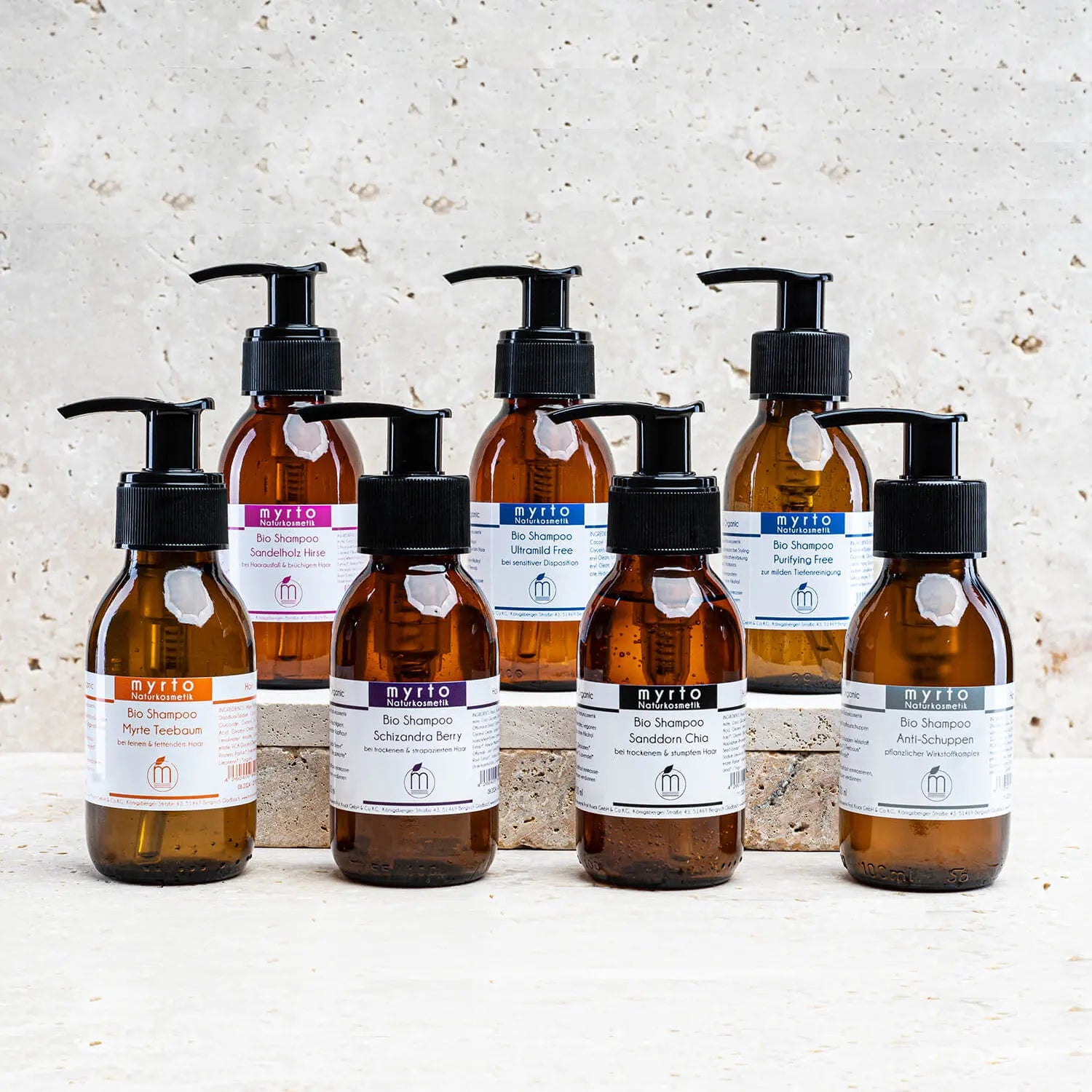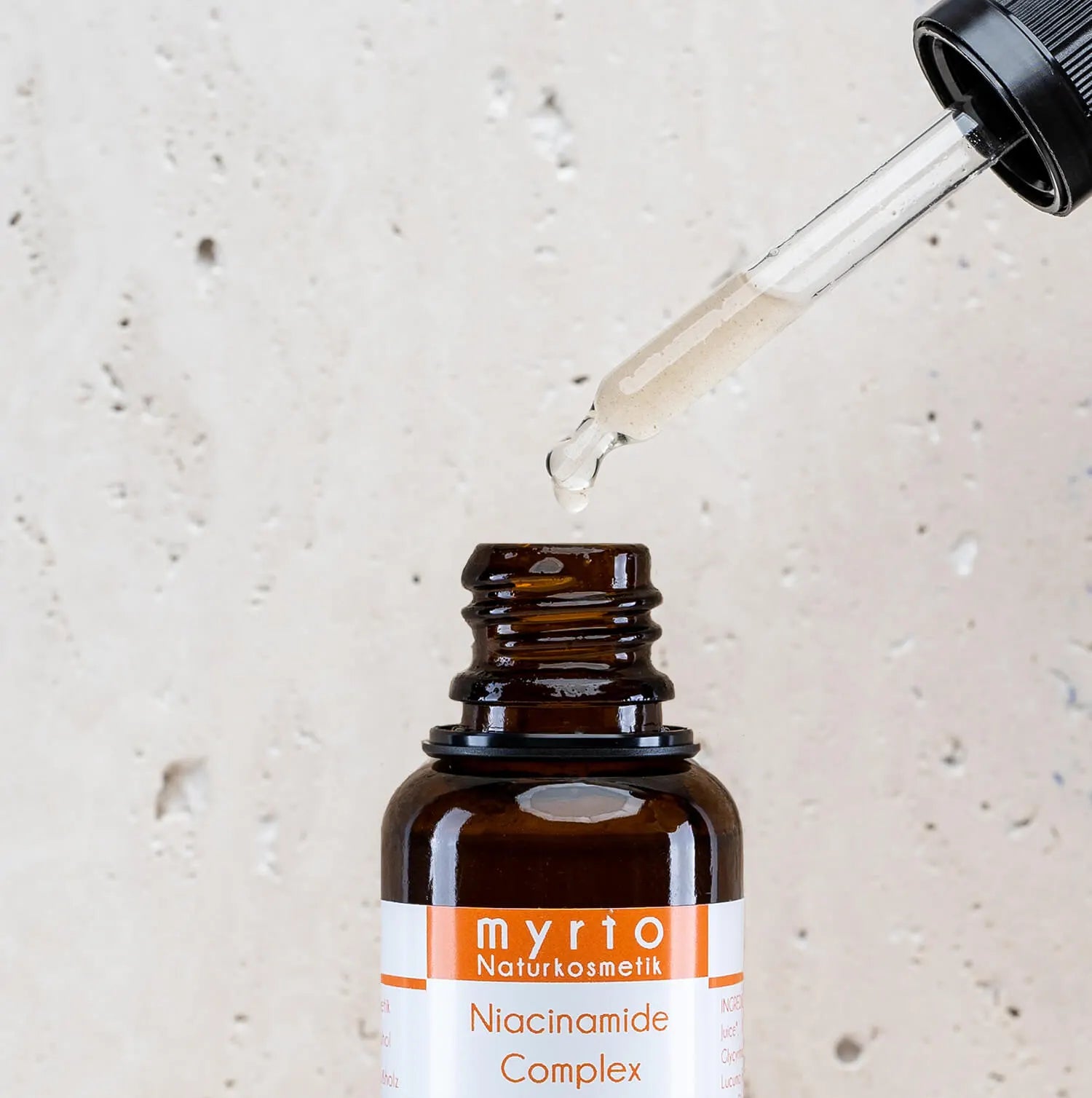
How do you recognize a good hair care shampoo?
What makes a high-quality hair shampoo?
Most shampoo manufacturers advertise selected plant extracts and vitamins to care for and strengthen hair. In natural cosmetics, silicones, parabens, phthalates and microplastics are also avoided - and many consumers are convinced and buy the product. But is that really all we have to look out for when buying a high-quality shampoo? What should you really look for first and foremost in a good shampoo?
A good shampoo should thoroughly remove dirt and sebum from your hair, but should not irritate the scalp. Above all, it should not damage the hair's natural, thin fatty acid film. This protective film around each individual hair ensures that the hair does not dry out, but remains elastic, has a natural shine and does not become straw-like or split.
When choosing a hair care shampoo, it is definitely worth getting comprehensive information beforehand. The wrong choice can quickly lead to greasy, stringy or brittle hair, and a dry, itchy or irritated scalp. If you have a sensitive scalp in particular, you should carefully find out which hair care product is best. But since the decision is not that easy, we will give you a few tips for successfully choosing the right hair shampoo.
Surfactants as the most important quality feature of a shampoo
To recognize a really high-quality shampoo, you should take a closer look at the ingredients. This primarily concerns the detergent substances or surfactants. They are the most important quality feature of a shampoo.
According to the EU Cosmetics Regulation, all ingredients of a cosmetic product must be listed in descending order in terms of quantity on the ingredients list. They are referred to using their Latin technical terms and can be researched on online portals such as Codecheck.de. Shampoos usually contain mixtures of several surfactants. The primary surfactant is at the front, usually directly behind water (aqua). It forms the washing-active basis of a shampoo. Surfactants that are found at the back of the ingredients list are usually only used in amounts of less than 1%. They only modify the foaming ability, the washing power and the viscosity of the shampoo.
Why are sulfates a concern as primary shampoo surfactants?
Conventional hair care shampoos as well as shower gels or bubble baths usually contain ether sulfates. These synthetic surfactants made from polyethylene glycols (PEGs) consist mainly of ethylene oxide. Ethylene oxide is a highly toxic chemical that is considered to be mutagenic, teratogenic and carcinogenic.
PEG-based surfactants include the ether sulfates sodium lauryl sulfate (SLS), sodium laureth sulfate (SLES) and ammonium lauryl sulfate (ALS), which are known to be skin irritants. These sulfates have the highest irritating potential. Nevertheless, they are the most commonly used primary shampoo surfactants - simply because they are cheap to produce. These PEG-based surfactants have a high allergy potential and are often the cause of dry, irritated mucous membranes and eyes, reddened scalp, skin irritations, neurodermatitis, headaches or nausea. PEGs also damage the membrane function of the scalp and make it permeable, allowing harmful substances to enter the body and accumulate there.
PEGs are also a huge burden on the environment. It can take decades for these chemicals to be completely broken down by microorganisms in rivers, lakes and seas. Surprisingly, surfactants made from ether sulfates can also be found in high-priced, medically recommended pharmacy shampoos specifically for sensitive skin.
PEG surfactants are characterized by lush, large-pored foam formation. The general rule for the irritation potential of a shampoo is: the more lush and large-pored the foam of your shampoo, the more aggressive and drying the surfactant mixture is for your scalp and hair.
Are surfactants in certified natural cosmetic shampoos really always recommendable?
Of course, we only expect naturally-based surfactants in certified natural cosmetics. However, natural cosmetic shampoos that are certified by Ecocert, for example, often contain the surfactant coco betaine (cocamidopropyl betaine). In addition to coconut fatty acids, this surfactant also contains a component from the petroleum chemistry. If used for a long time, coco betaine can cause allergic skin reactions or hair loss, and can make the eyes and mucous membranes hypersensitive. In 2004, it even received the inglorious title of "Allergen of the Year".
The natural cosmetic surfactant sodium coco sulfate is also not well tolerated by the skin. It is used as the primary surfactant in almost all certified natural cosmetic shampoos. Sodium coco sulfate is not only made from coconut fatty acids, as is often claimed, but it also contains an equally large proportion of substances of petrochemical origin - something that manufacturers like to keep quiet about. According to the Zein test and HET-CAM test, sodium coco sulfate has considerable skin-irritating potential. It dries out hair, scalp and mucous membranes unnecessarily. The unpleasant side effects include irritated, reddened skin, irritated mucous membranes or itchy, dry scalp. When choosing your shampoo, therefore, make sure that the surfactant sodium coco sulfate is at least not at the top of the ingredients list - i.e. it is not the primary surfactant in your shampoo.
Mild vegetable surfactants: glucosides / sugar surfactants
The skin-friendly and ecologically safe natural washing raw materials of the latest generation include the so-called sugar surfactants (glucosides). Glucosides are non-ionic surfactants. They are made from a combination of coconut oil fatty acids and glucose (fruit sugar). You can recognize glucosides in your shampoo by ingredient names such as Coco Glucoside, Decyl Glucoside or Lauryl Glucoside. Glucosides tend to produce a weak foam. Shampoos with glucosides as the primary surfactant can sometimes result in a build-up effect when used for a long time, which can make the hair look stringy or heavy.
The top class of mild plant-based surfactants: Amino acid surfactants
The top class of mild, plant-based surfactants of the latest generation are the so-called amino acid surfactants (acyl glutamates) with their moisturizing properties. With their fine-pored, soft micro-foam, they are anionic, sulfate-free surfactants. In addition to the amino acid glutamine from glucose, amino acid surfactants are made from coconut oil. They significantly outperform sugar surfactants in terms of their optimized skin compatibility, hair-care properties and rapid biodegradability. Detergent amino acids (disodium / sodium cocoyl glutamates) are usually only used in low concentrations as co-surfactants because they are many times more expensive to produce than all other surfactants.
In all 7 myrto organic shampoos we use amino acid surfactants (disodium / sodium cocoyl glutamate) with their skin-friendly buffering effect as the primary surfactant in maximum concentration. What are the advantages?
- The protective thin fatty acid film of the hair fiber remains undamaged, so that the hair does not dry out, become dull, straw-like or split.
- The moisture balance of hair and scalp is improved.
- The sebum production of the scalp is brought into balance.
- The hair becomes more resilient and elastic.
- The hair gets more natural fullness.
What other quality features are there in a shampoo?
As a further quality feature, we only use natural plant oils, proteins and plant extracts from organic farming in the myrto organic shampoos, depending on the hair type and individual care needs. All ingredients comply with the usual natural cosmetics certifications and in some cases even go beyond them. All 7 myrto organic shampoos are vegan, alcohol-free and preservative-free. For sensitive, allergy-prone skin and sensitive dispositions, there is the Ultramild Free and Purifying Free Shampoo without fragrances. This makes the myrto hair care extremely skin-friendly, strengthens the skin barrier and protects against moisture loss.





